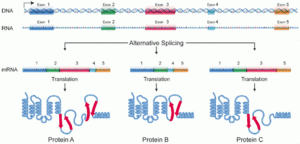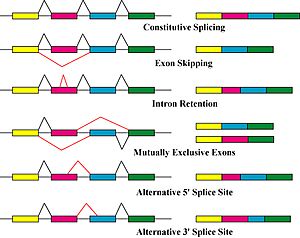Protein isoform facts for kids

A protein isoform (say: EYE-so-form), or "protein variant," is like a different version of a protein. These versions come from the same gene or group of genes. Even though they come from the same gene, they can have slightly different structures.
Many protein isoforms do the same or very similar jobs in the body. But some can have totally unique functions!
These different versions can be made in a few ways:
- Alternative splicing: This is when the cell chooses different parts of the gene's instructions to build the protein.
- Using different starting points (called promoters) when reading the gene.
- Other changes that happen after the gene's instructions are copied but before the protein is built.
Scientists discovered isoforms when they realized that humans have fewer genes than expected, but a huge variety of proteins. This means one gene can make many different proteins, which helps explain the diversity!
Contents
What are Protein Isoforms?
A single gene can create many different proteins. These proteins might look different and have different parts. This happens mainly because of alternative splicing. Imagine a recipe book where you can skip or add certain steps to make different versions of the same dish.
The specific type of protein isoform made depends on the cell type and how far along the body is in its development. It gets even more complex when a protein is made of several pieces, and each piece can also have different isoforms!
For example, a protein called AMPK (which helps cells use energy) has three main parts:
- Alpha (α) part: This is the main working part. It has two versions: α1 and α2.
- Beta (β) part: This helps control the protein. It has two versions: β1 and β2.
- Gamma (γ) part: This also helps control the protein. It has three versions: γ1, γ2, and γ3.
In your muscles, the most common AMPK version is α2β2γ1. But in your liver, the most common version is α1β2γ1. This shows how different versions of the same protein can be found in different parts of the body.
How Protein Isoforms are Made

The main ways protein isoforms are created are through alternative splicing and using different promoters. Think of promoters as "start" signals on a gene.
Alternative splicing is a key process. After a gene's DNA is copied into a message called mRNA, this mRNA still has some parts that don't code for protein (called introns). A special cell machine called a spliceosome cuts out these non-coding parts.
With alternative splicing, the spliceosome can choose which parts to keep and which to remove. This means it can create different mRNA messages from the same original gene. Each different mRNA message then leads to a different protein isoform.
Even though alternative splicing is carefully controlled, sometimes "mistakes" happen, creating even more different mRNA messages. Scientists are still learning if all these different versions are actually useful or if some are just "noise."
What Makes Isoforms Different?
Usually, one protein isoform is considered the "standard" or "main" version. This is often because it's the most common or similar to versions found in other animals.
Most isoforms are very similar to the standard version and share many of the same parts. Because of this, they are often thought to have similar jobs. However, some isoforms can be very different. They might even have completely different functions! For example, one isoform might help a cell live, while another might cause it to die.
Scientists are still studying all the different functions of protein isoforms. It's a big puzzle to figure out what each version does.
Examples of Protein Isoforms
Here are some examples of proteins that have different isoforms:
- G-actin: This protein is very important for cell movement and structure. Even though it's very similar across many living things, mammals have at least six different versions of it.
- Creatine kinase: This enzyme helps with energy in your muscles. It has three different versions. Doctors can check for these versions in your blood to help diagnose a myocardial infarction (heart attack).
- Hyaluronan synthase: This enzyme makes a substance called hyaluronan, which is important for joints and skin. It has three versions in mammals.
- UDP-glucuronosyltransferase: This group of enzymes helps your body get rid of harmful chemicals and medicines. There are 16 known versions of this enzyme in humans.
- Monoamine oxidase: This family of enzymes helps break down certain chemicals in the brain. It has two versions, MAO-A and MAO-B.
See also
 In Spanish: Isoforma para niños
In Spanish: Isoforma para niños
- Gene isoform

